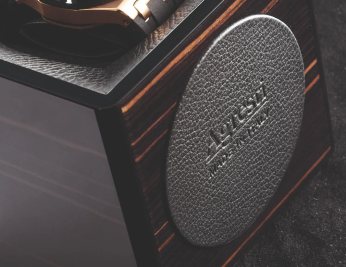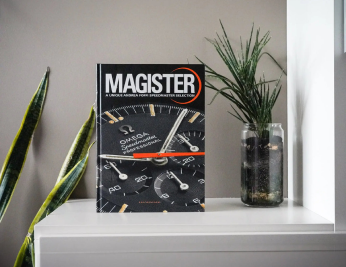If one were to rank the five most iconic chronographs in the world of watchmaking, the Omega Speedmaster would undoubtedly be one of them. The Speedy is one of those watches that has left an indelible mark not only on the wrists and hearts of us fans, but also in history.
When we talk about the Omega Speedmaster, we immediately think of the Moonwatch: a historic watch, famous for being on the wrist of the astronauts on the first moon landing, serving and assisting in one of the most important feats in the history of mankind.

Indeed, it was a well-deserved privilege: the Speedmaster was chosen for its robustness, for its efficiency; it was chosen simply because it was the best.
The tests and trials that the various candidates have had to endure are impressive: resistance to severe acceleration, operation at critical temperatures and much more. Many have failed, others lacked very little, but only one caliber really succeeded, proving to be up to such an important role.

This caliber is the Omega 321. After the great triumph of the moon landing, this movement was replaced by the equally famous Omega 861, decreeing the end of production of the 321.
Omega recently announced the return to production of the historic 321: the news was received with all the appreciation that a movement of this value deserves, and we at IWS would like to introduce you to how and why the caliber 321 has become one of the best and most sought after chronographs.

The birth: the Lemania 2310
In fact, the 321 was not originally designed for the Speed; in fact, it first appeared in 1946, more than ten years before the original 1957 Speedmaster.
The 321 was born from a collaboration between Lemania and Omega. The Lemania 2310, introduced on the market in 1942, is the movement from which the 321 takes inspiration. (Small spoiler) The name under which this caliber will be marketed will not be 321, but we will talk about that later.

The Lemania 2310 is still one of the most popular supply movements in the world of manual chronographs today. The quality of its mechanics was appreciated to such an extent that it was used several times as a workbench for calibers of other historic houses.
Patek Philippe’s CH27-70, Vacheron Constantin’s 1140 caliber, Roger Dubuis’s RD56 or Breguet’s Caliber 533.3, are all calibers that see 2310 as inspiration.
The robustness of this movement, combined with its efficiency and, let’s face it, its aesthetic appeal, have contributed to making the Lemania 2310 one of the most important chronograph calibers in watchmaking history.
The 2310, and consequently the 321 by Omega, is precisely a chronograph movement with manual winding, quite small compared to the average (27 mm in diameter); this made it possible to use very robust speakers without being too large.

The balance wheel oscillates at 2.5 Hz (18,000 vibrations per hour), the engagement of the chronograph is lateral – like almost all the movements present at the time – and the sorting of functions takes place via the much appreciated column wheel.
Sorting with a column wheel has always been a detail much appreciated by enthusiasts, both for the complexity of construction and for the inherent elegance of this system.


Since 1968 with the transition to Omega’s new 861 movement, the column wheel leaves the Speedmasters, giving way to a more robust but – if you like – less elegant cam shifting.
The recent reintroduction of the new 321 has caused quite a stir among enthusiasts, happy to discover that the beloved column wheel is back on the Speed.
Here is a very interesting anecdote that characterizes the Lemania 2310: long before 1969, the year of the first automatic chronographs, this movement was modified and updated to equip an automatic winding system.
An ante litteram automatic chronograph, which in a completely silent way was the first to give life to a watchmaking concept so normal today, that of the automatic chronograph. The automatic 2310 is extremely rare: at the moment we are aware of only a few photos, posted on the Omegaforums.net forum.
The first Omega’s 321 Caliber
Omega decided to adopt this caliber for the first time in 1946, on a series of three-counter chronographs with steel or gold cases. The name of this caliber was not 321, but 27 CHRO C12, the real name born from the collaboration between Lemania and Omega.
This unusual name embodies the main characteristics of the caliber: 27 as the millimeters in diameter, CHRO as the complication that the movement offers and C12 as the actually measurable chronograph hours.
In 1957 Omega gave the world its first Speedmaster, with the now proven 321, so identified starting in 1949.
Commonly known by the pseudonym “Broad Arrow” due to the particular shape of the hands, this model was created to be used on the track: between races and competitions, dust and rain, this is the environment of the first Speed.

Accuracy and reliability were mandatory, and the 321 was the perfect movement. The original Broad Arrow, reference CK2915, is today one of the most sought after and appreciated Speedmasters by collectors, making these watches reach dizzying prices.
In 1959 the design of the Speedmaster was changed: hands no longer broad arrow but in dauphine style, the diameter of the case was increased, passing from 39 mm to 40 mm, and the tachymeter bezel no longer metallic. These are some details that characterize the reference CK2998, becoming one of the first models to pass the NASA fitness tests.
In 1965 the new reference ST105.003 officially became NASA’s watch: the case assumes an asymmetrical shape in order to ensure greater protection of the crown and chronograph buttons and the hands become baton.
The Speed thus takes on the design we are used to today, so much so that it is commonly known as “Pre-Moon”. This reference is remembered for being on astronaut Ed White’s wrist during the first US “spacewalk”.
The famous 1969 space expedition saw the real “Moonwatch” on the wrist of Buzz Aldrin and Neil Armstrong, the Omega Speedmaster reference ST105.012, obviously with the 321 inside.
With this reference, from 1966, the word “Professional” appears on the dial, a word that in addition to identifying the degree of importance that characterizes this watch, represents how much watchmaking has been fundamental for scientific and technological evolution.
1968 begins the production of the omega caliber 861, based on Lemania 1873, marking the gradual abandonment of the 321.
The return of caliber 321: legends never die
In 2019, Omega announces a special edition of the Speedmaster, on the occasion of the 50th anniversary of the moon landing. The watch is presented exactly fifty years after the heroic feat, and what better opportunity to show something truly exceptional.
The watch is in the classic style of the Speedmaster, with an asymmetrical platinum case, onyx dial and sub-dials that recall the lunar soil. But the real surprise is below the dial: the legendary caliber 321 reappears.
The commitment and dedication that Omega has invested to faithfully reproduce the historic movement have been truly admirable: it took two years for Omega to honor the 321, thanks to a team of engineers, historians and master watchmakers.
Omega has used the most modern technologies to be able to create scans and reconstructions of the movement, starting from none other than the Speedy caliber (ST105.003) worn by Eugene Cernan during the Apollo 17 mission in 1972.

Each Omega caliber 321 is edited and assembled by the watchmaker himself, who also takes care of the assembly of the bracelet and the movement in the case. In short, all the attention that an authentic legend deserves is reserved for this caliber.
At the beginning of 2020 Omega announces a new Speedmaster, completely different from what we are used to: the Speedmaster Ed White enters the scene, in honor of the famous astronaut who tragically died in the Apollo 1 accident in 1967.
This new model is a bit of a turning point in today’s Speed panorama: symmetrical case without crown and push-button protections, Omega logo applied without the wording “Professional”, but above all here is the caliber 321 again.
It is clear that Omega is trying to restore glory and importance to its historical models; you can see it from Ed White, or from the 1957 trilogy, which includes the Railmaster, the Seamaster and the Speedmaster, all three recalling the original style of the technical Omega of the 1950s.
At the end of 2021 Omega announces another model, completely in line with this philosophy: the Speedmaster in Canopus Gold. A watch with a vintage flavor, elegant and traditional in every detail.
The style faithfully recalls the first Speed of 1957 and as a further element in common the caliber 321, enclosed in a symmetrical 18-karat gold case.


Omega has really given its all to bring to light the legends that have made the history not only of this brand, but of the entire world of watchmaking, and in their way contributed to one of the most exceptional feats of man.
Omega’s caliber 321 is in our opinion at IWS the perfect example of that gratitude that every historic brand should have towards their glorious past, that genuine thanks to their own history and to history in general.
The 321 represents how a maison manages to go beyond the desire for something always new, bringing back to life not only a piece of its history, but a way of appreciating the past in a contemporary way, and we at IWS are honored to have introduced you to the birth, history and return of a myth.



















